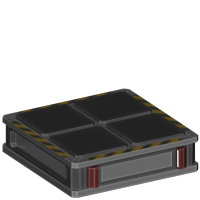Hurles Co.
| Hurles Co. | |
|---|---|
 | |
| Cargo Pad | |
| Small Cargo Pad that can hold up to eight cargo units | |
| Manufacturer | Hurles Co. |
| Device Type | Prop |
| Category: Systems | |
Hurles Corporation (Hurles Co.) is the number one shipping and mining corporation in the galaxy. It produces shipping containers, as well as several other shipping-related products.
History
Originally founded by Transport Tycoon J. Hurles in 3140, it was the first company to mine the mineral-rich asteroids surrounding the Earth colony Ypsilon 5. It's first mining vessel, the HSC Sagittarius, was launched in 2154 after 14 years of construction and housed 16 crew. After mining for over six months, a radiation leakage incident killed 7 crew members and rendered 6 of them critically ill, forcing the spacecraft to make an early return. After the incident, Hurles Co. Chief of Science Gina Cadmillan admitted that mistakes had been made. Due to inherent design flaws, the Sagittarius would never leave the surface of Ypsilon 5 again.
Five years after the near-loss of the Sagittarius, the company was nearing bankruptcy, risking everything on the rapid completion of it's second mining vessel, the HSC Aster. The HSC Aster was completed in a record time of 5 years and 4 months, on January 5th 3160. It featured 8 crew and a brand new reactor design to avoid a re-occurance of the disaster on board it's predecessor. With funding only allowing it to mine for a period of five months, the Aster was launched into Ypsilon 5's orbit on January 8th, three days after it's completion.
After five full months of mining, the Aster returned to it's home base in Terra Nova, Ypsilon 5. This time, the mission was succesful in retrieving precious platinum and gold ore from the asteroid belt. Proving that the Hurles Corporation could successfully mine the asteroids surrounding Ypsilon 5 with a large profit, the Aster was immediately scheduled for five more mining missions in the next 13 years, before finally being decommissioned and exhibited in the Terra Nova Museum of the Sciences in September 3180. a The success of the HSC Aster laid the foundation for future mining operations. Five-Hundred more Mining vessels were built, until the seemingly never-ending resources of the asteroid belt started to show signs of depletion in 3840. The still flourishing Hurles Corporation launched a long-range research vessel, the HSC Prometheus. It's mission was long-range reconnaissance. After seven years, a new candidate for the company's mining needs was discovered. A small moon, located in the Taksian system at a distance of nearly five lightyears. A few years earlier, the nation of Melvania on Ypsilon 3 launched the first iteration of their new means of faster-than-light propulsion. They called it the Hyperdrive.
The advent of the Hyperdrive meant that other stars were reachable within the human lifespan for the first time in history. A new generation of Hurles Co. Vessels were constructed to take advantage of the mining opportunities of the Taksian system. Even with the Hyperdrive, the journey to the Taksian system would still take two full years. To cross the enormous gap, and bring the valuable resources back to the Ypsilon System, several enormous cargo vessels were constructed. These proved so efficient, that Hurles Co. gradually shifted it's business from a solely mining oriented company, to an interstellar transport conglomerate.
Fleet
Nowadays, the Hurles Co. fleet consists of thousands of cargo vessels. The flagship of the fleet is the 500 meter long HSC Aurora Alpha. Acting as a mobile headquarters, the crew on the Aurora Alpha is responsible for the planning of the company's mining and shipping operations.